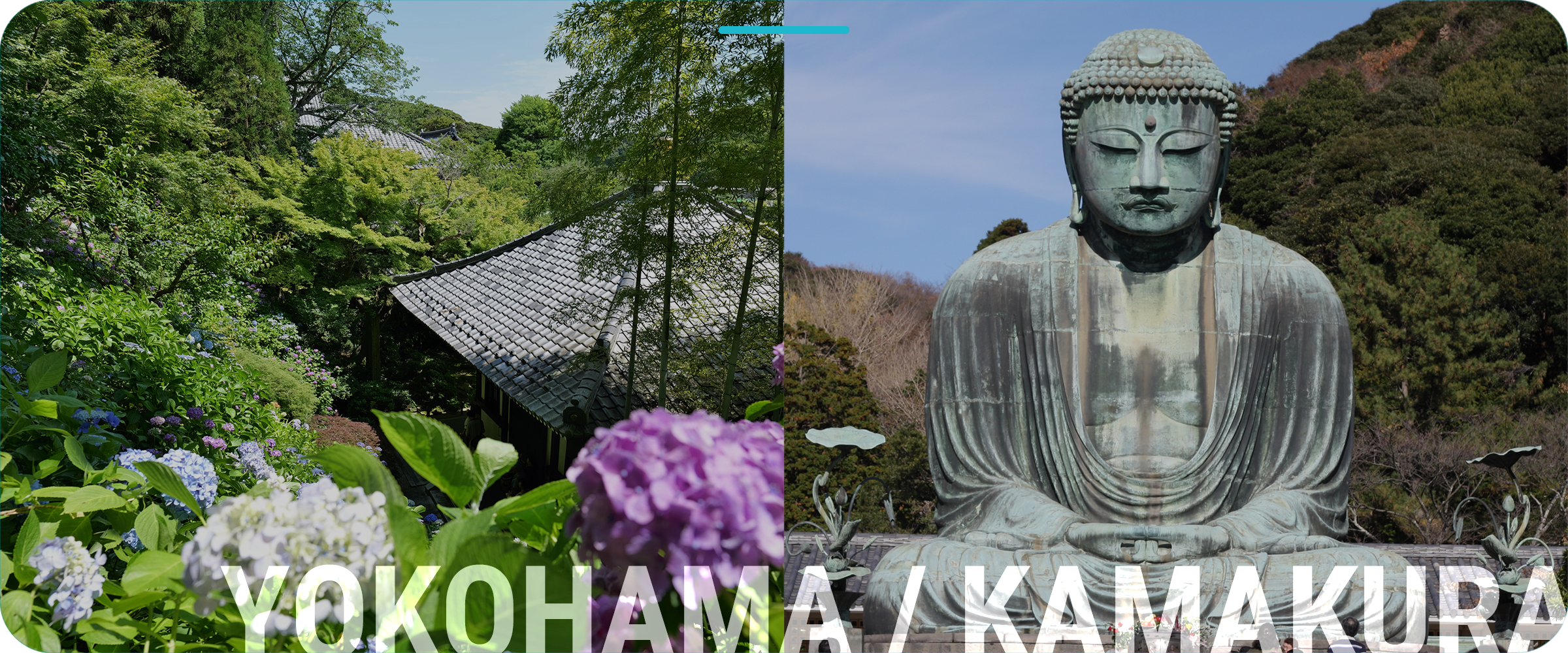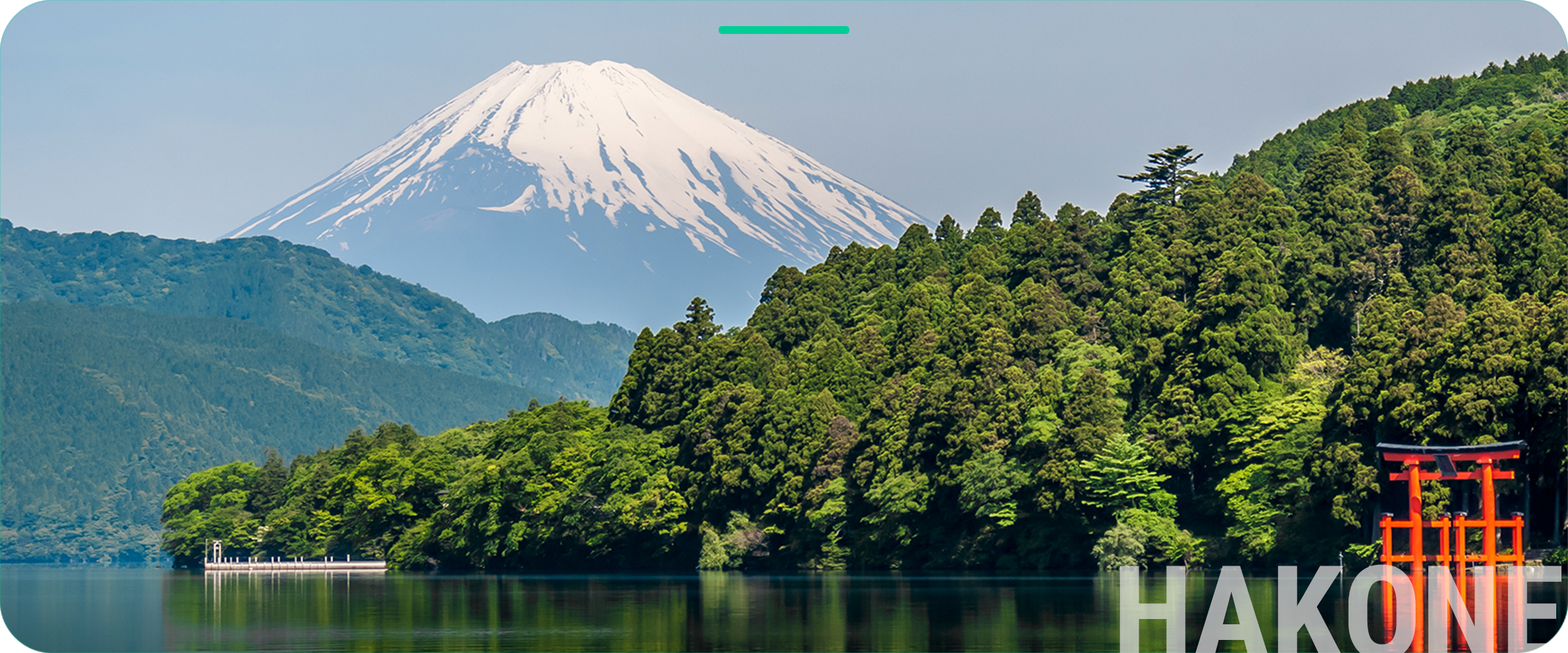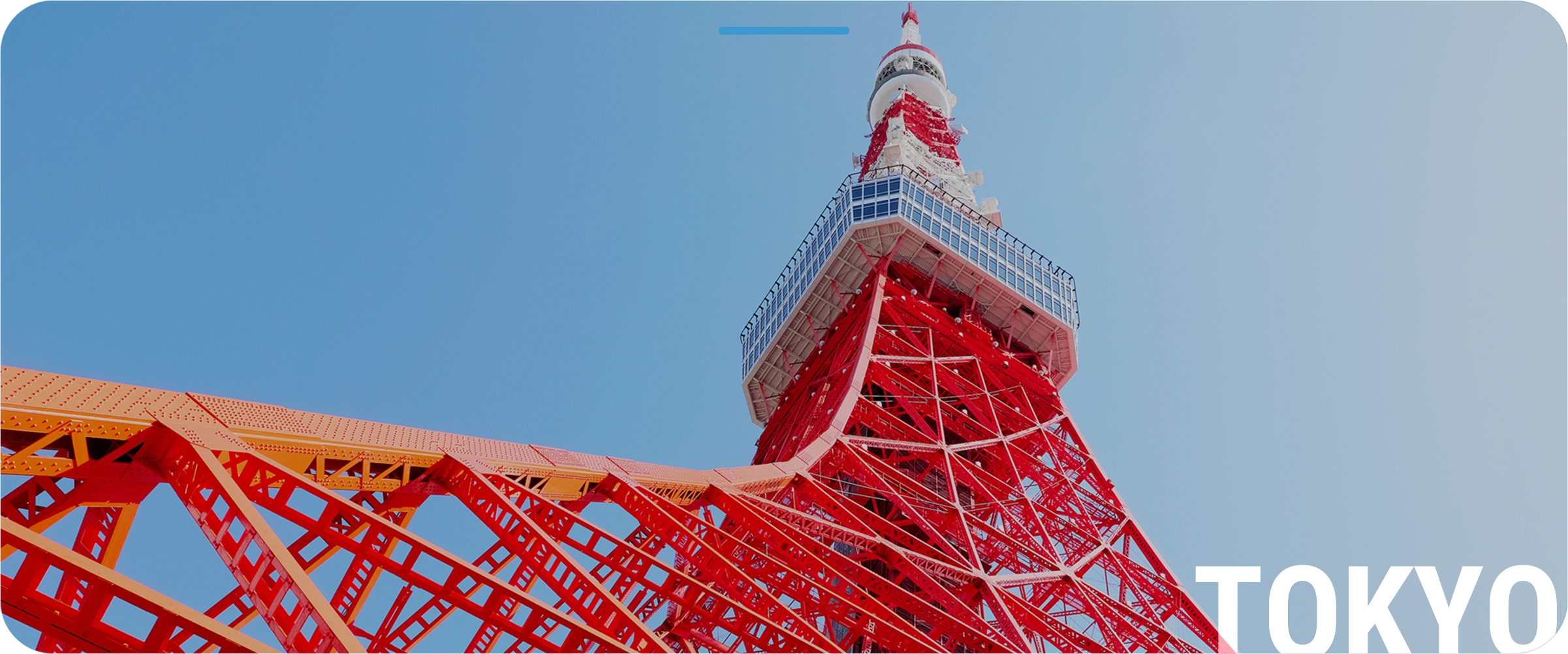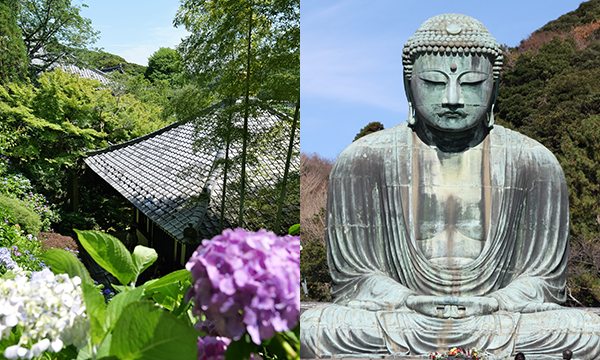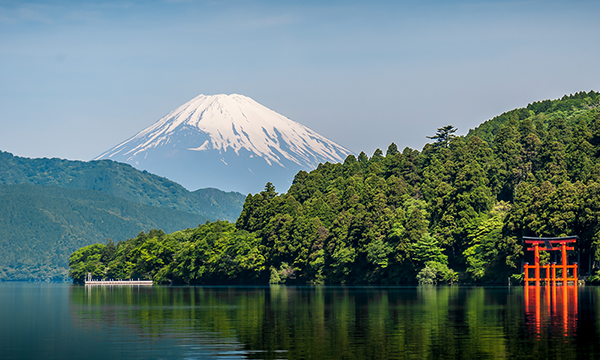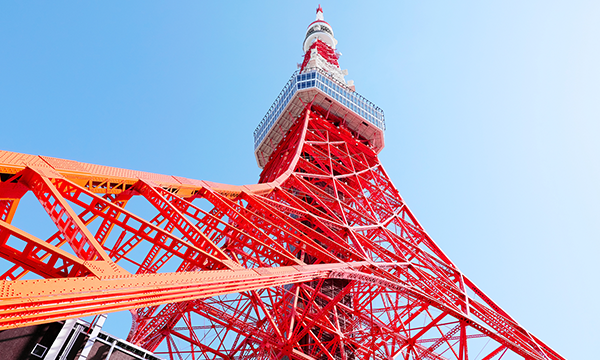TRAVEL YOKOHAMA, KAMAKURA, HAKONE,
AND TOKYO AND DISCOVER THE BEAUTY OF JAPAN
If you want to experience something different than the usual in Japan, rent a car and drive to Yokohama, Kamakura, or Hakone where you might discover something new. But if it’s your first time in Japan, you can enjoy yourself in Tokyo as well.
Here we introduce some recommended routes to visit by car, so if any destination sparks your interest, why not visit? We also introduce some easily accessible bus tours in Tokyo.
YOKOHAMA/KAMAKURA AREA

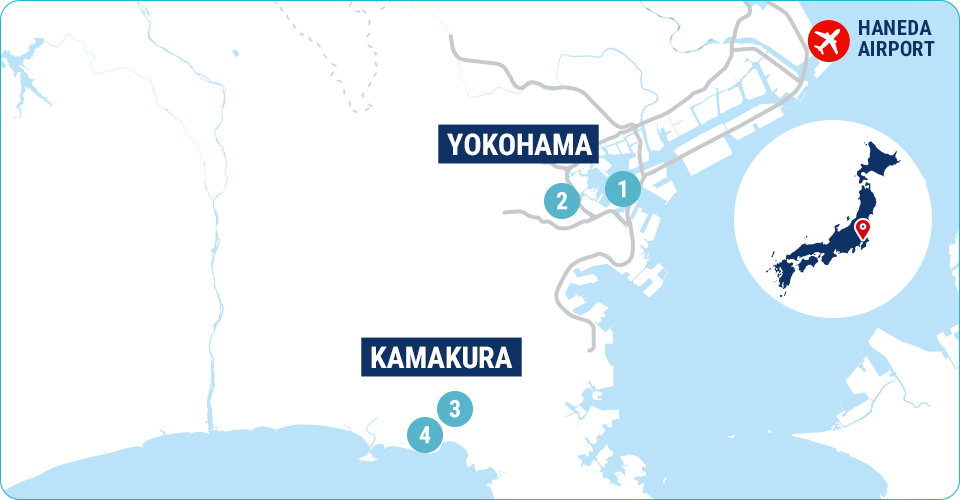
Yokohama Bay Bridge
From (B)Haneda Airport to Yokohama Bay Bridge
A part of the Bayshore Route connecting Honmoku futo and Daikoku futo.
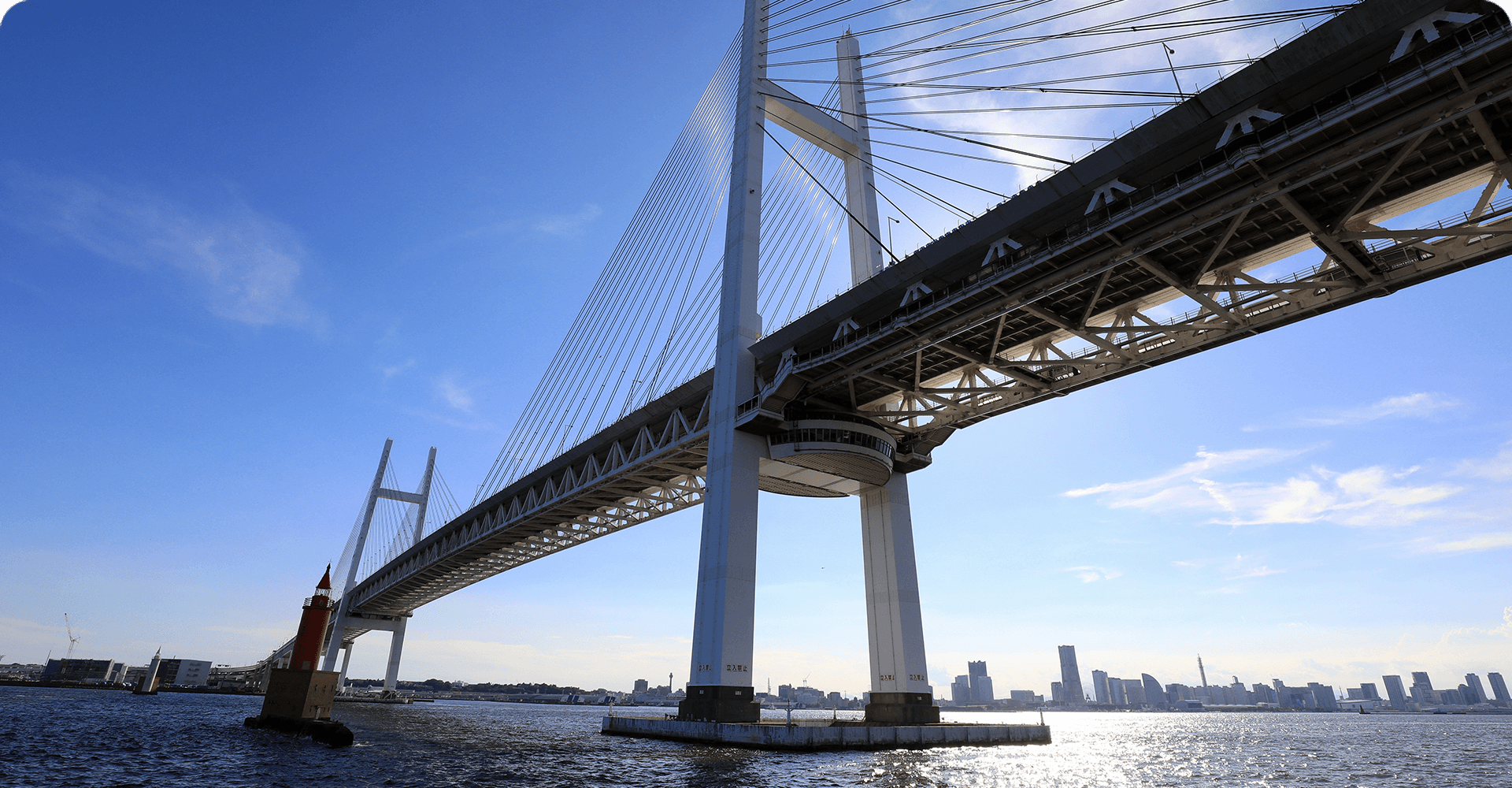
The Yokohama Bay Bridge is a cable-stayed bridge with suspension on two sides that forms part of the Bayshore Route connecting Honmoku futo and Daikoku futo. The bridge was constructed over a period of eight years, beginning in 1981 and opening to traffic in 1989, in order to enhance the port functions of the international Port of Yokohama.
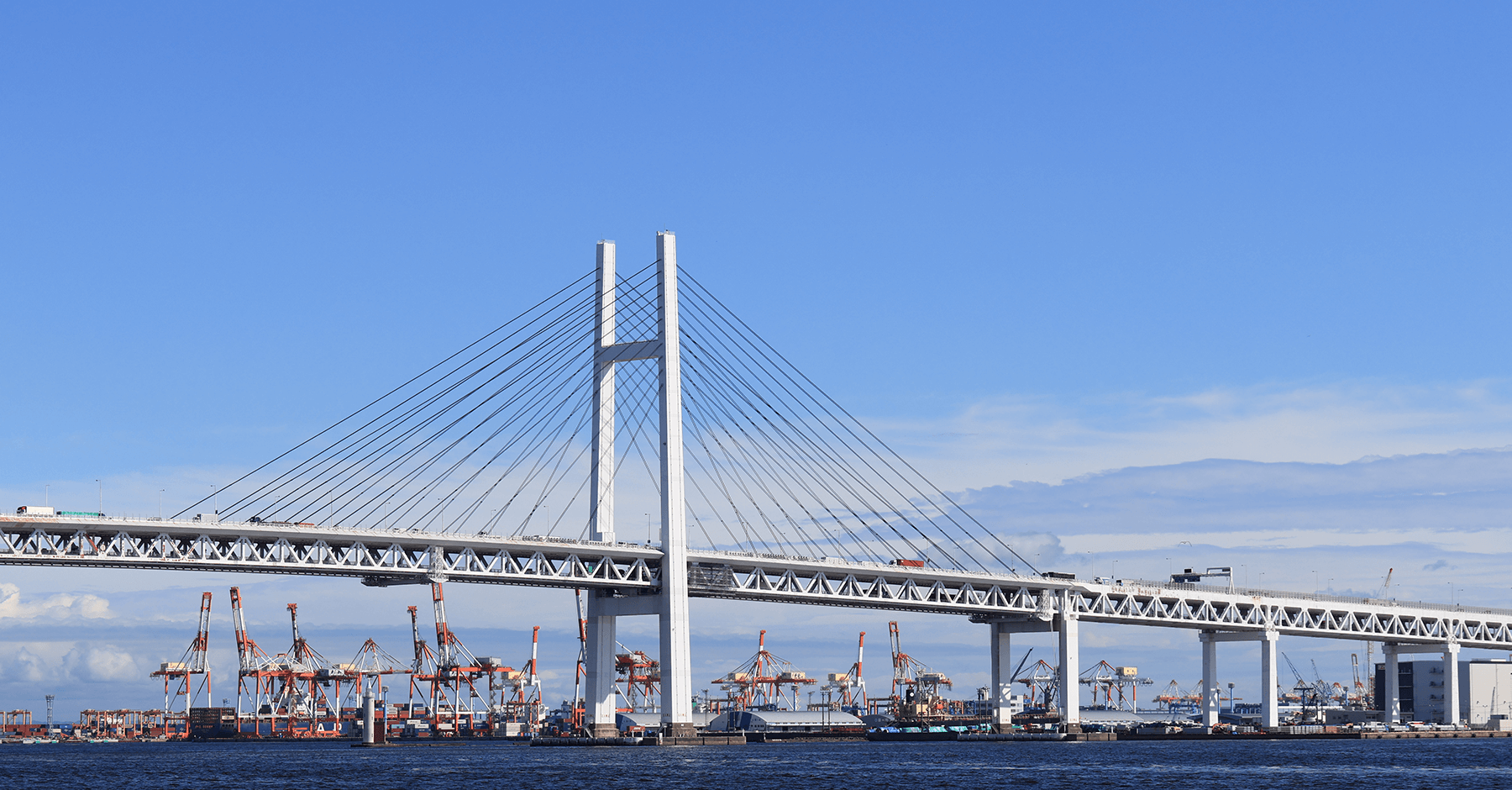
The bridge, measuring 860 meters in length, features two decks, with the upper deck serving as the Metropolitan Expressway Bayshore Route and the lower deck as National Route 357, and cannot be traversed by bicycles or pedestrians. The bridge serves as an important transportation route connecting the Port of Yokohama with areas further inland.
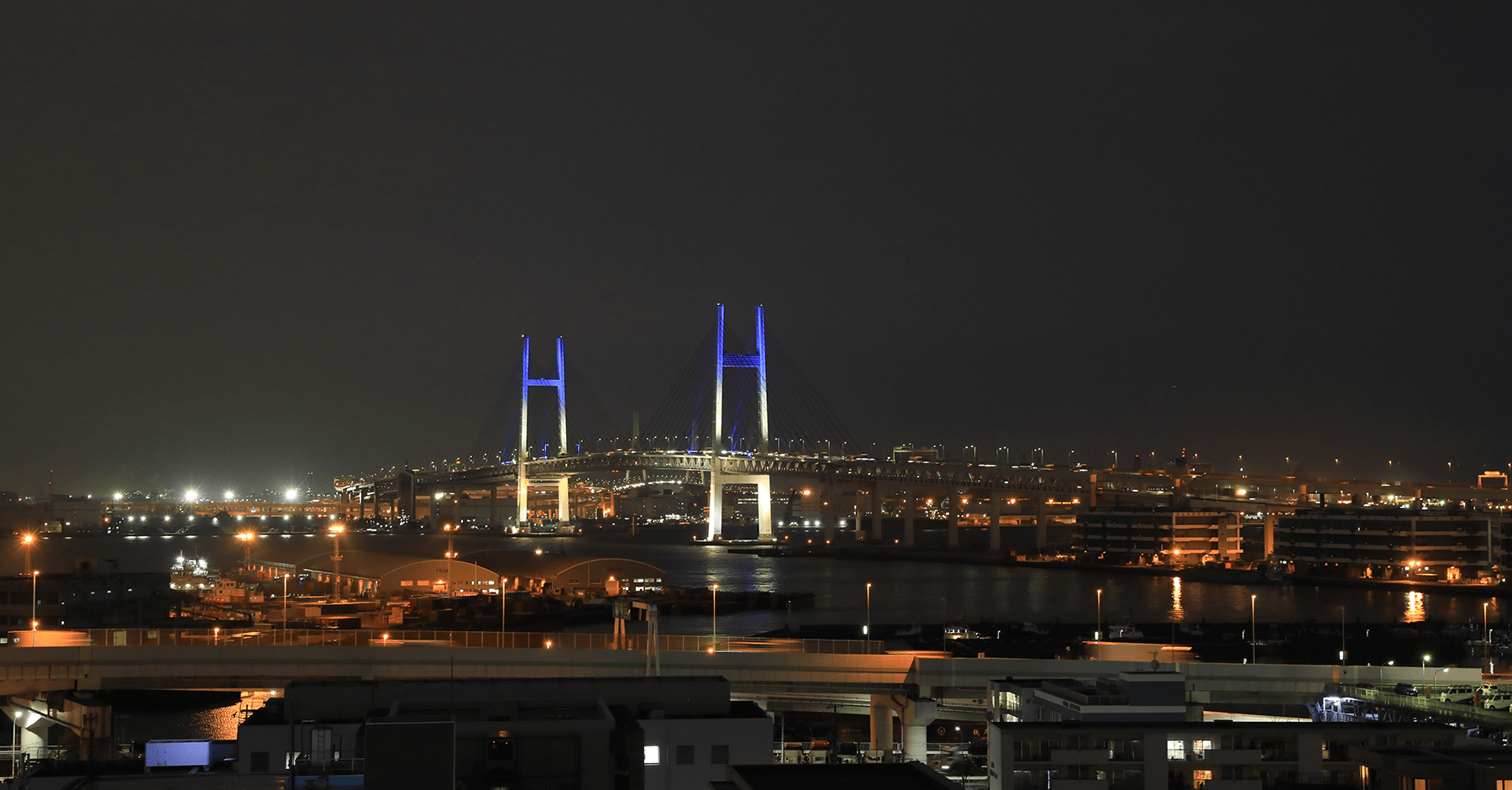
The Yokohama Bay Bridge offers a beautiful night view after the sun sets. The bridge’s main towers are illuminated by 264 floodlights, greatly enhancing the nightscape of the Port of Yokohama.
The top 40 meters of lighting on the main towers turns blue twice each hour for 10 minutes each, starting at 20 minutes past the hour and 50 minutes past the hour. The fixed timing of the color change also serves to denote the time, a feature which the locals appreciate and make use of. This lighting display lasts from sunset until midnight.
Basic information
Yokohama Bay Bridge
- Structural form
- Cable-stayed bridge
- Bridge length.
- 860m
- Center span
- 460m
- Main tower height
- (above sea level) 175m
- Bridge's inauguration
- September 27, 1989
- Address
- Honmoku futo, naka-ku, yokohama-shi, kanagawa-ken
Google Map - Web
- https://www.shutoko.co.jp/en/index/driving/explore/baybridge/overview/
See the facility websites for the latest information.
MORE
 15min
15minGourmet Dining in Yokohama
From Yokohama Bay Bridge to Yokohane Line(K1)
About 7 min. from(K1)Yokohama-koen
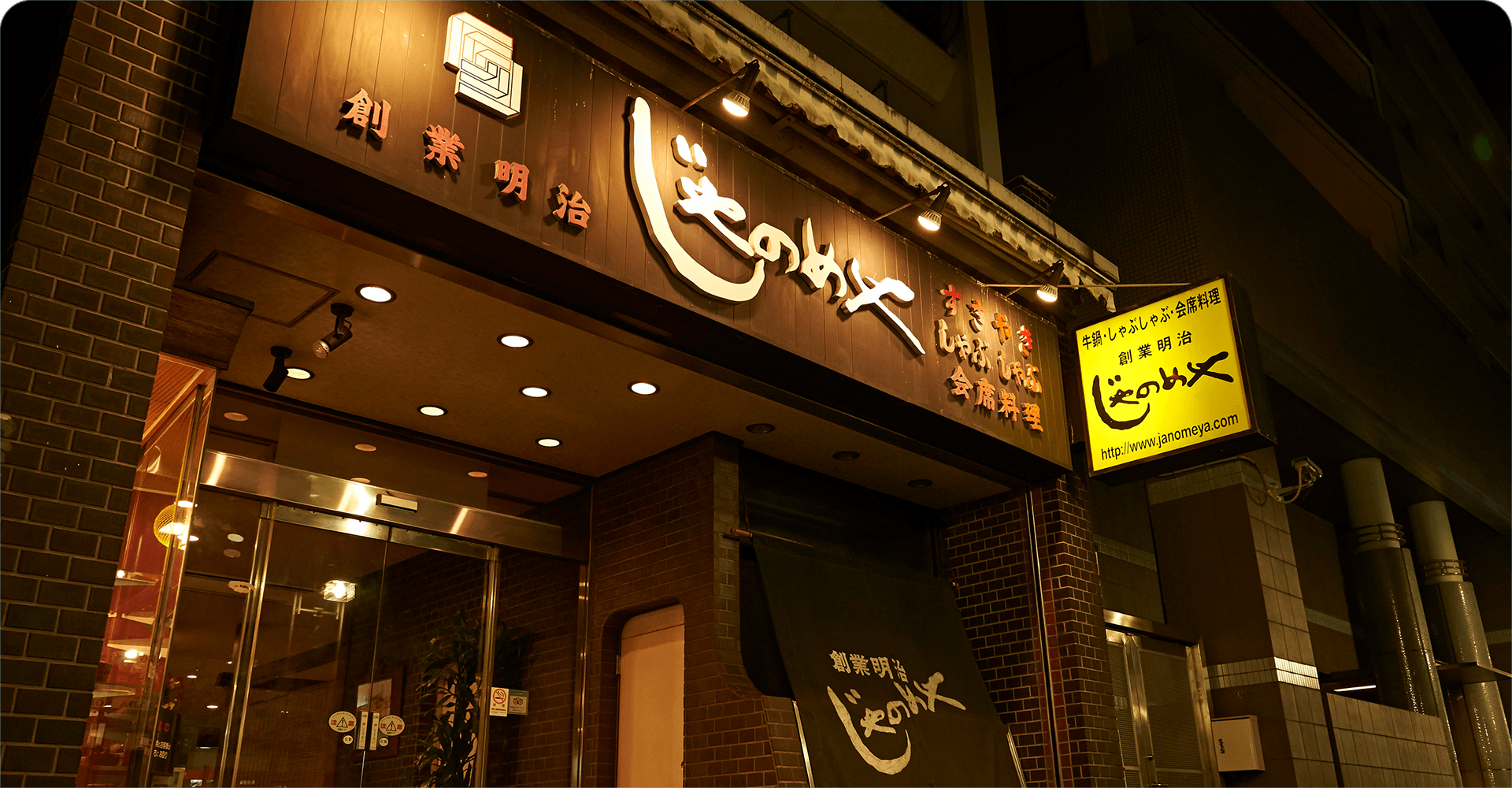
Janomeya is a venerable beef hot pot restaurant established in 1893. Though only a small food stall when it first opened, they later established a restaurant in Isezakicho, and have since maintained their traditional taste for more than 130 years.
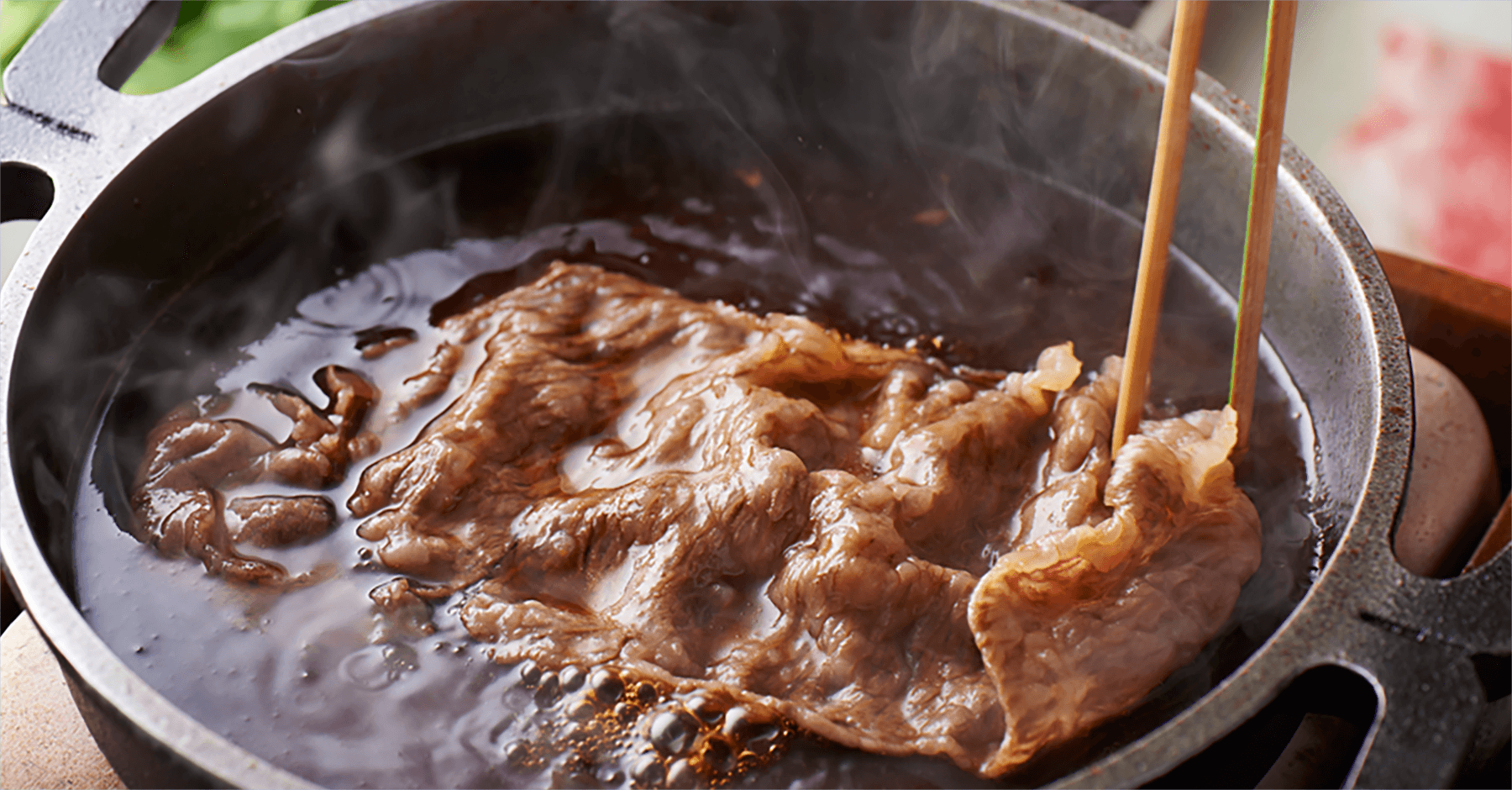
With the end of the Edo period and the long period of isolation, Japan opened up to the world, and western influences introduced the culture of consuming beef. As a result, beef hot pot, or Gyu-Nabe, was born in Yokohama.
While similar to the well-known Japanese dish Sukiyaki, the difference is that the ingredients are placed in the sauce and simmered from the start with Gyu-Nabe rather than grilling them first.
At the time, the people of Japan were hesitant to eat beef, so the restaurant prepared the meat using familiar seasonings such as Miso, soy sauce, and sugar, and gradually the dish grew in popularity. Since then, the Gyu-Nabe served by Janomeya has been loved by countless diners.
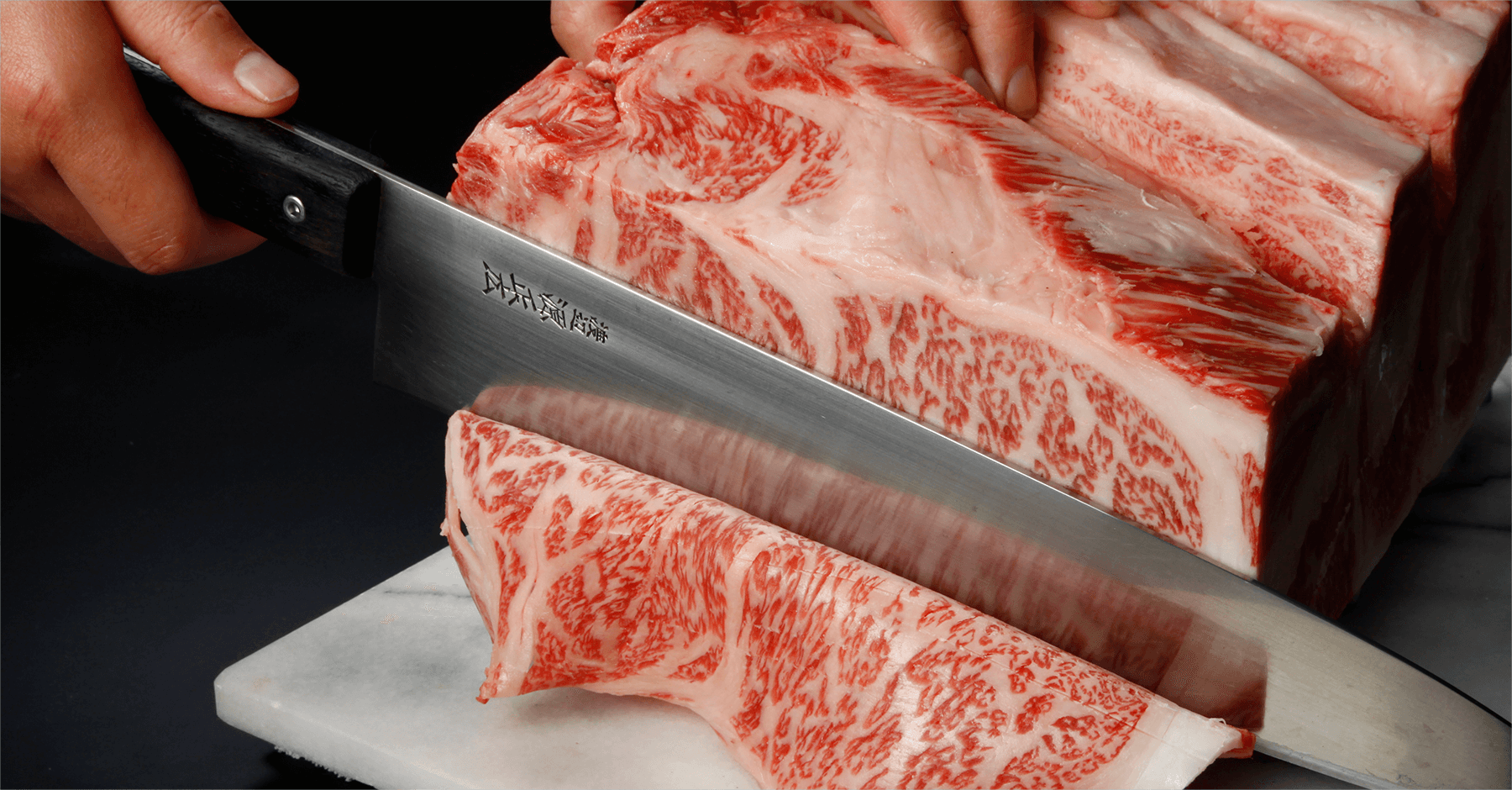
The main area where Janomeya refuses to compromise is to use only the ingredients that they identify as being the best. The quality of meats is measured using the combined criteria of “yield grade,” or the ratio of good meat obtained from the animal, and “meat quality grade,” or the color and luster of the meat. All of the beef served at Janomeya has achieved the highest possible rank of A5 for both yield grade and meat quality grade.
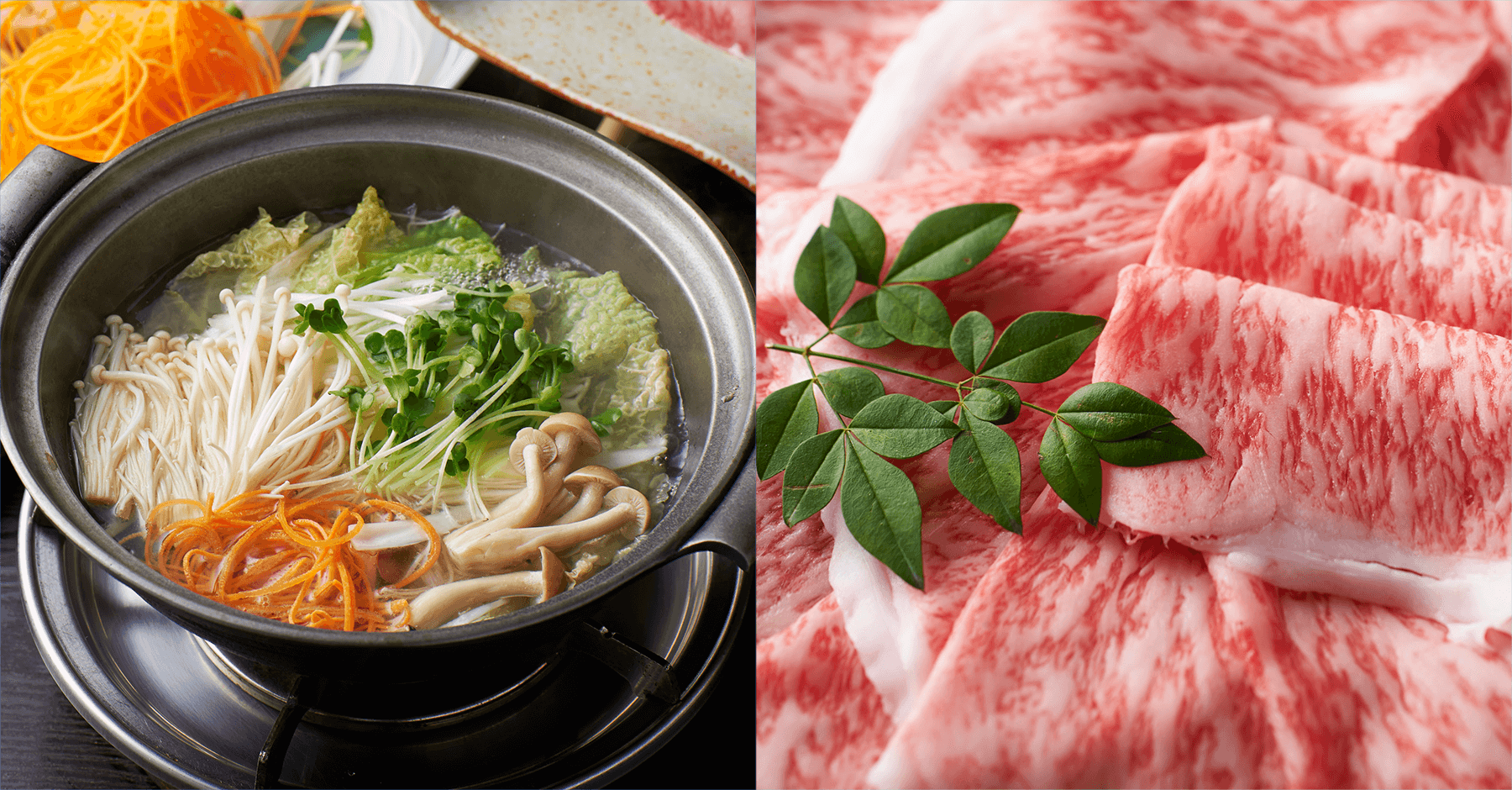
The ingredients other than meat, such as vegetables, have also been carefully selected. In addition to Gyu-Nabe, flavored in almost the exact same way as when they first opened, they also serve such popular dishes as Shabu-shabu.
The restaurant interior, with a subdued atmosphere that retains the mood of the original restaurant, features tables in private rooms where groups can focus on enjoying each other’s company. There are also smaller private rooms for those who wish to dine in privacy.
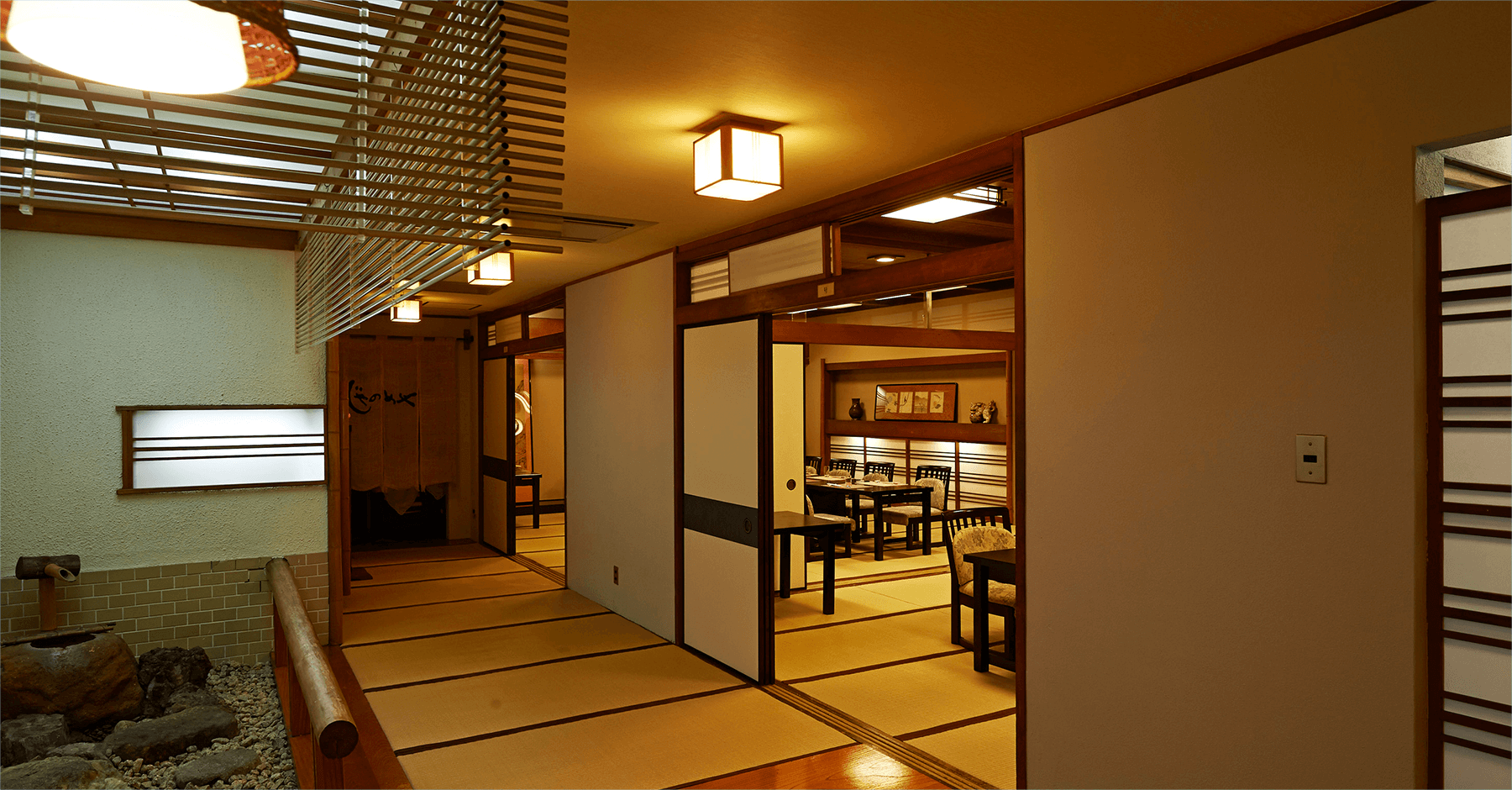
Basic information
Janomeya
- Address
- 5-126, isezaki-cho, naka-ku, yokohama-shi, kanagawa-ken
Google Map - Phone
- 045-251-0832
- Opening Hours
- Tue. - Fri. 17:00~21:00(L.O.) / Sat.Sun.National holiday 12:00~21:00(L.O.)
- Holiday
- Monday, First Sunday (Ask about holidays in December and January.)
- Seats
- We can serve a maximum of 2–50 customers
- Parking
- 3 cars
- Web
- https://www.janomeya.com/english.html
See the facility websites for the latest information.
MORE
 45min
45minInteract with History in Kamakura
From Yokohama-koen to YOKOHAMA-YOKOSUKA ROAD(E16)Asahina IC
About 20 min. from(E16)Asahina IC
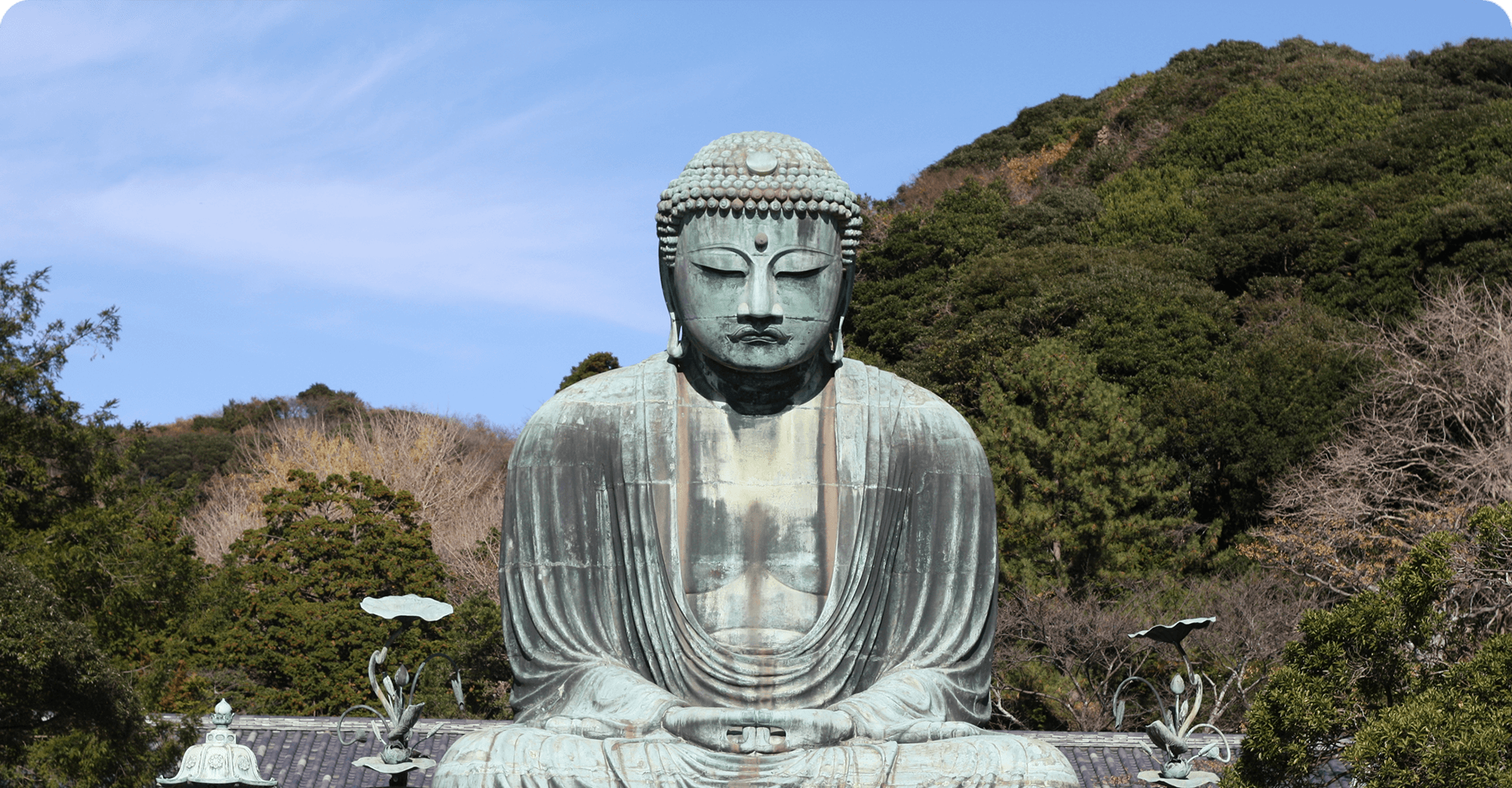
Urban development began in Kamakura with the establishment of the Kamakura Shogunate, reaching its heyday and becoming the center of Japan by around the year 1230. Today, many historic buildings remain in this ancient city.
The seated bronze statue of Amitābha is known more familiarly as the Great Buddha of Kamakura. Reaching approximately 11.3 meters in height, the massive statue of Buddha weighs approximately 121 tons. The statue resides within the grounds of the Kōtoku-in Buddhist temple. Much of the circumstances surrounding the statue’s original construction are shrouded in mystery, and it is not precisely known who built it and for what purpose.
The statue initially resided within a Great Buddha Hall, but became exposed to the elements when that hall was destroyed by a tsunami, a state in which it remains today. Its location outdoors has also given it the alternative name of Roza no Daibutsu, or the Great Buddha Seated Outdoors.
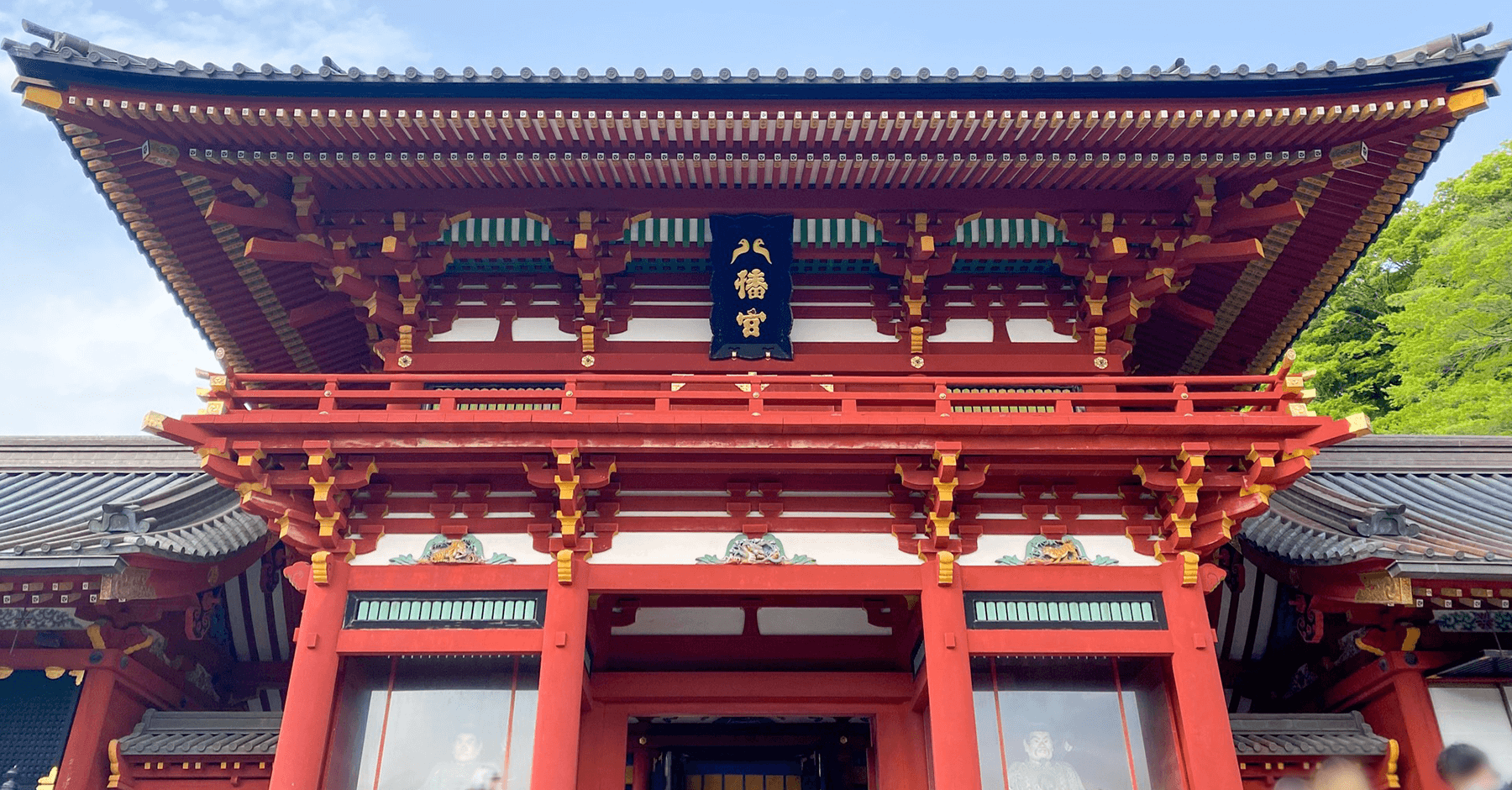
The famous Shinto shrine known as Tsurugaoka Hachimangu is deeply associated with the first Shogun of the Kamakura Shogunate, Minamoto no Yoritomo, and the shrine was once thought to serve as the guardian deity of the Minamoto clan. However, the power wielded by the shrine waned with the decline of the Kamakura Shogunate, and the shrine was even burned to the ground during the Warring States period, but it was later greatly expanded during the Edo Period, including the construction of the main hall ordered by Ienari Tokugawa, achieving the impressive scale we see today.
There is much to see within the grounds, such as the Genpei Pond which features cherry blossoms in the springtime with pink and white lotus flowers in summer.
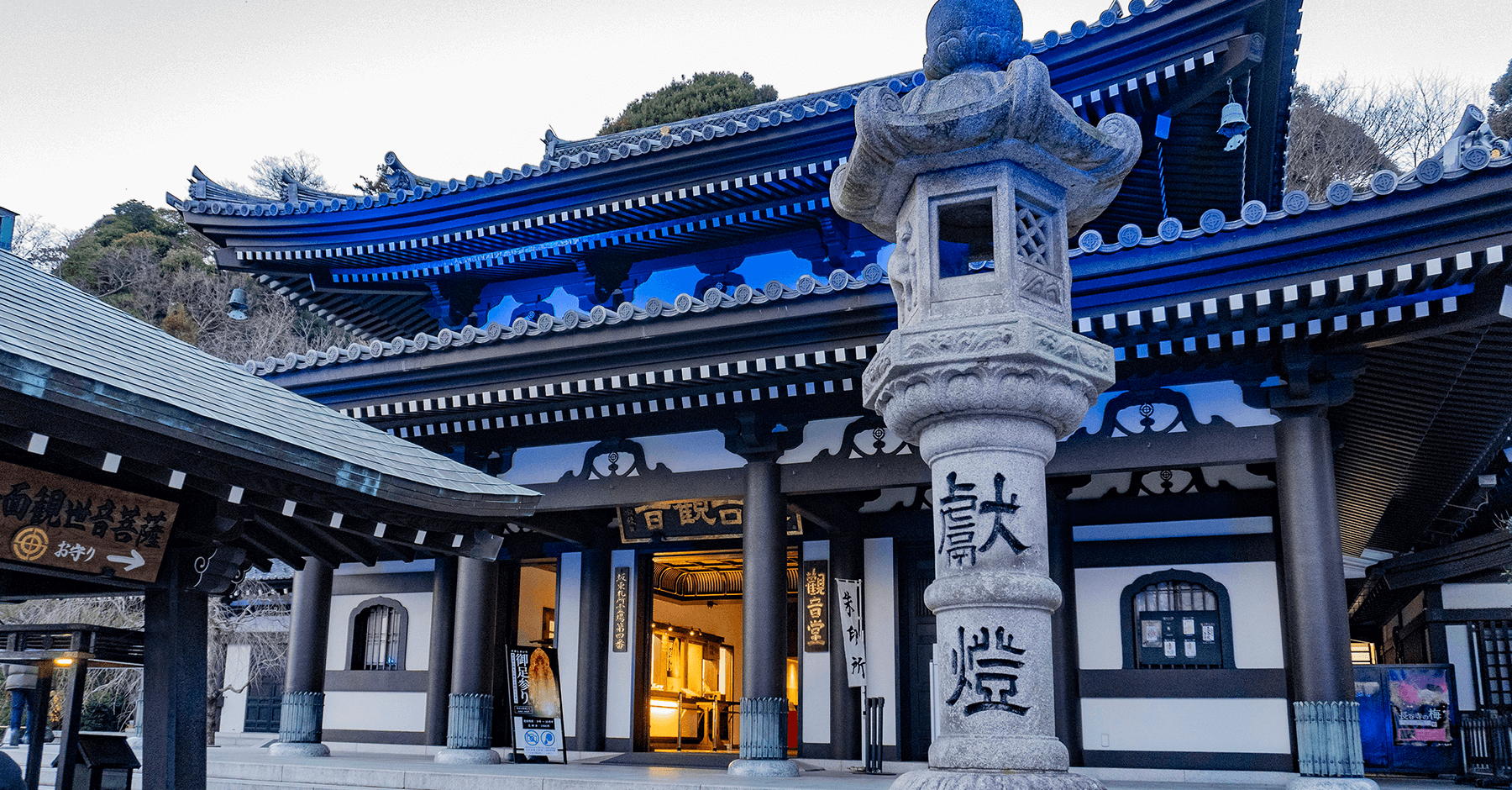
Hasedera Temple is loved by the locals under the colloquial name of Hase Kannon because its main hall, the Kannon-Do, enshrines an upright statue of the eleven-faced Kannon goddess, the principal deity of the temple. The temple has a long history, and it is said to have been originally constructed during the Nara period. The official name of the temple in Japanese is “Kaikozan Jishoin Hasedera.”
The upright statue of the eleven-faced Kannon goddess offers an impressive sight, standing on a rock throne with a Khakkhara, or pewter staff, in her right hand, and a vase of flowers in her left, and she has eleven faces arrayed on her head. According to legend, this Kannon statue is said to be one of two such statues created at the request of Tokudo Shonin, who constructed another Hasedera Temple in Nara. The statue was released into the sea as an offering, but is said to have reappeared off the coast of Sagami Bay 15 years later, prompting the establishment of Hasedera Temple in Kamakura.
There is an observation deck located within the grounds of Hasedera Temple that offers a view of the seas of Sagami Bay and the streets of Kamakura, and the path leading to and from it are lined with 2,500 hydrangeas in 40 different varieties, blooming in vibrant colors during the rainy season.
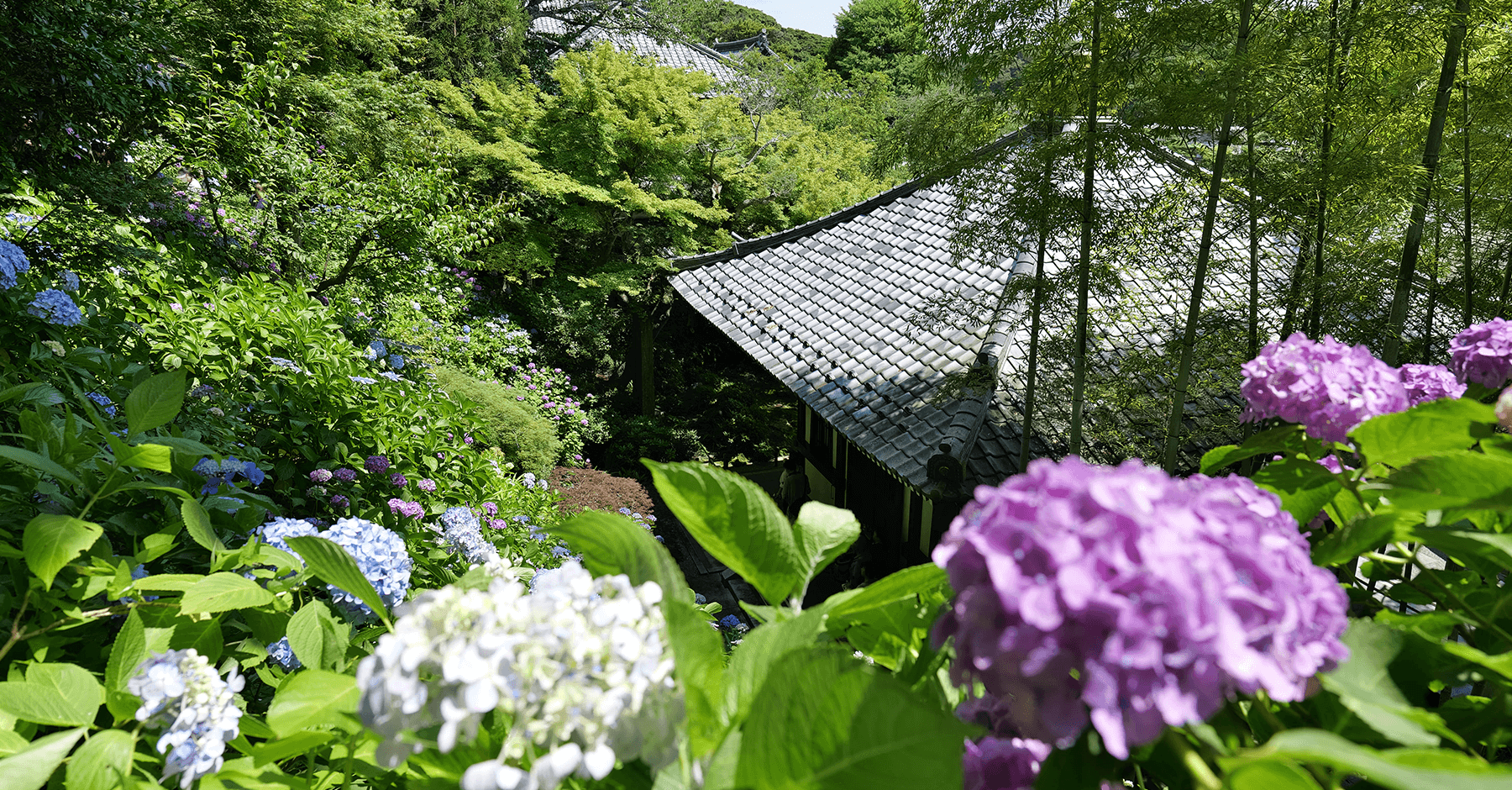
Basic information
Kotoku-in
- Address
- 4-2-28, Hase, Kamakura, Kanagawa Prefecture
Google Map - Opening Hours
- April–September 8:00 a.m.–5:30 p.m.,
October–March 8:00 a.m.–5:00 p.m.
*Visitors may enter up to 15 minutes before the temple closes.
To enter the interior of the Great Buddha statue 8:00 a.m.–4:30 p.m.
*Visitors may enter up to 10 minutes before closing time. - Admission fee
- General admission 300 yen
Child admission (age 6-12) 150 yen
Fee to enter the interior of the Great Buddha statue Additional 50 yen per person - Parking
- For visitor’s personal vehicles use parking in the vicinity.
- Web
- https://www.kotoku-in.jp/en/
Tsurugaoka Hachimangu
- Address
- 2-1-31, Yukinoshita, Kamakura-shi, Kanagawa
Google Map - Opening Hours
- Year round 6am-8pm
- Parking
- 40 Standard Vehicle cars ; 9:00-19:30
*Up to 1 hour 600 yen. Every subsequent 30 minutes 300 yen. - Web
- https://www.hachimangu.or.jp/en/
HASEDERA
- Address
- 3-11-2 Hase,Kamakura, Kanagawa
Google Map - Opening Hours
- July – March 08:00 – 17:00 (last entry at 16:30)
April – June 08:00 – 17:30 (last entry at 17:00) - Admission Fee
- Adults 400 yen
Children 200 yen (Age 6 - 11) - Parking
- 30 cars ; Opening Times 08:00 –16:30 (April – June 08:00 – 17:00)
*Parking Fees Passenger Cars350 yen/30 min. - Web
- https://www.hasedera.jp/en/
See the facility websites for the latest information.
MORE
 10min
10minInteract with Nature in Kamakura
About 20 min. from(E16)Asahina IC
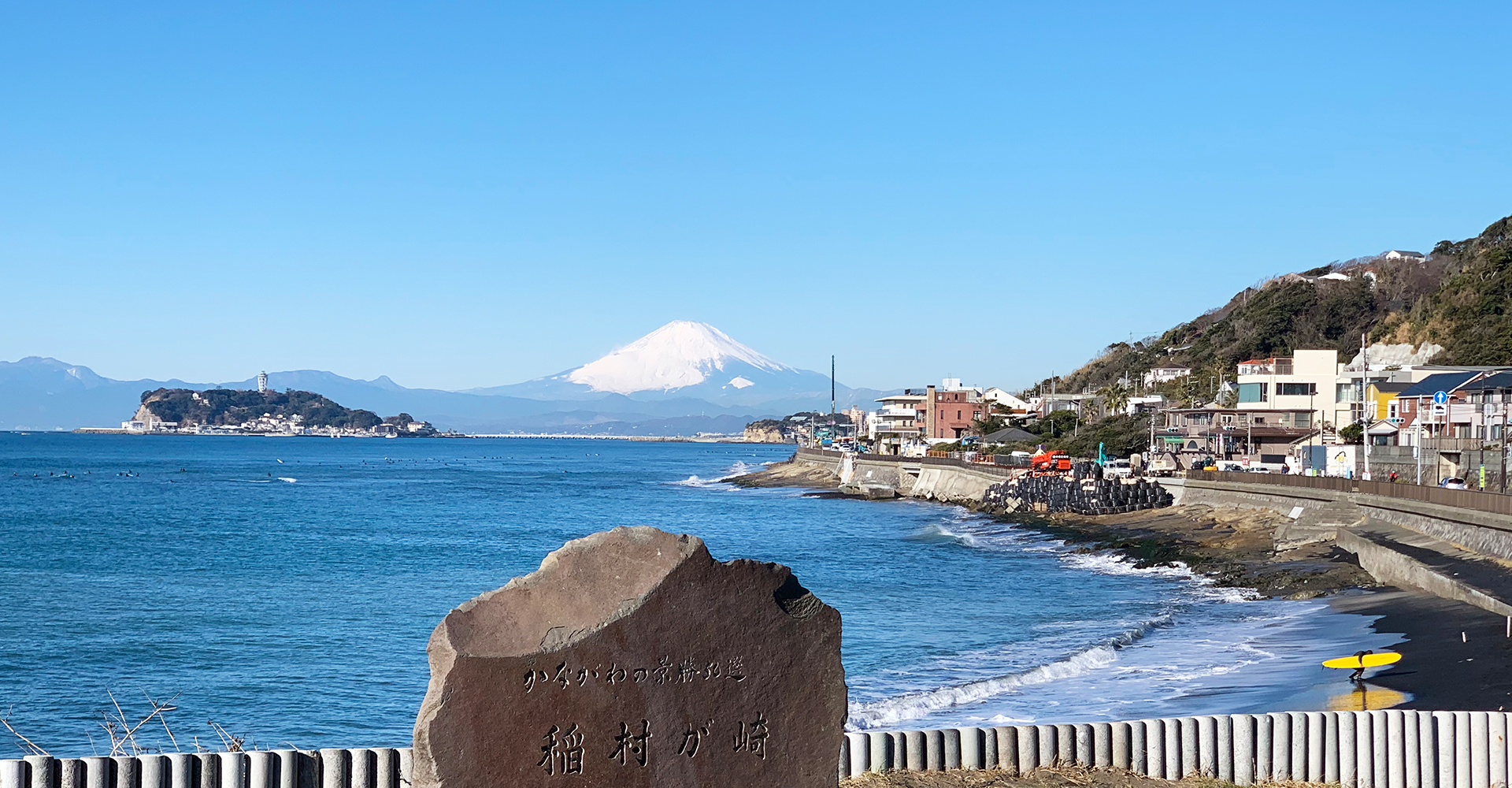
Visitors to Kamakura will also encounter scenery encompassing the vastness of nature. One such attraction is the Kamakura Seaside Park, which offers a chance to take in the beautiful views of the ocean.
Located along National Route 134, Kamakura Seaside Park faces the coast along Yuigahama and Inamuragasaki. The park covers a total area of 31.6 hectares and is divided into three sections, with a multipurpose ground in the Yuigahama section, an observation deck in the Inamuragasaki section, and a public pool in the Sakanoshita section. Each section offers its own atmosphere, and is equally loved by the locals. If you take a drive to visit all three, you will be able to enjoy the soft sea breeze on the way.
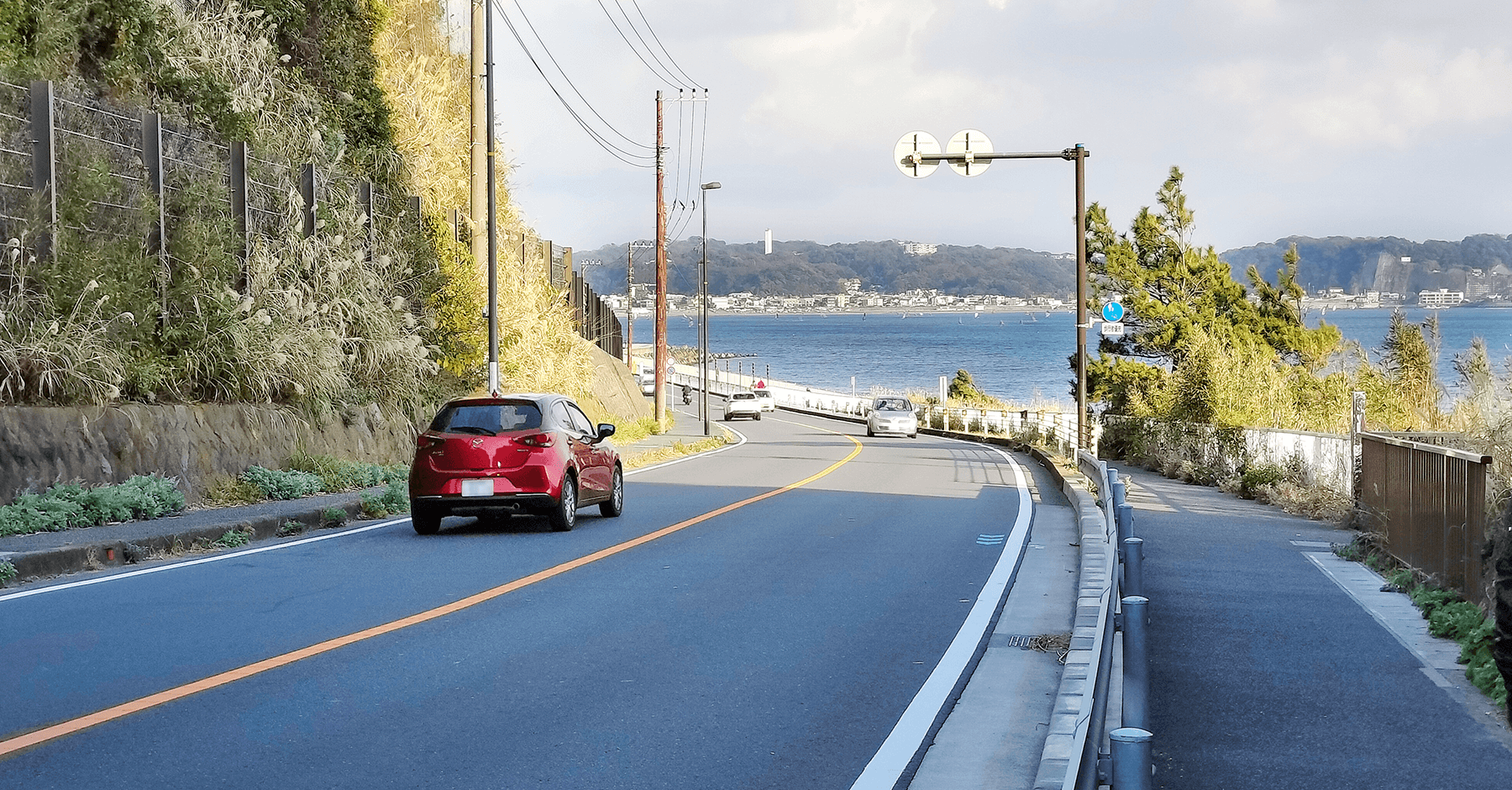
Of the three sections, the one offering the most beautiful scenery is the Inamuragasaki section, also known as Inamuragasaki Park. The observatory offers a clear view of Shichirigahama and Enoshima, and if you’re lucky, you will even be able to see the massive Mt. Fuji behind Enoshima. Taking advantage of the podium-shaped cape on which the park is located, visitors can enjoy different types of views by changing their perspective, looking out on the ocean from the seashore or climbing up to the observation deck.
The evening view is also particularly beautiful, and the orange sky over the setting sun juxtaposed against the twinkling lights of the seaside city, combined with the silhouette of Enoshima, are sure to make you forget the passage of time.
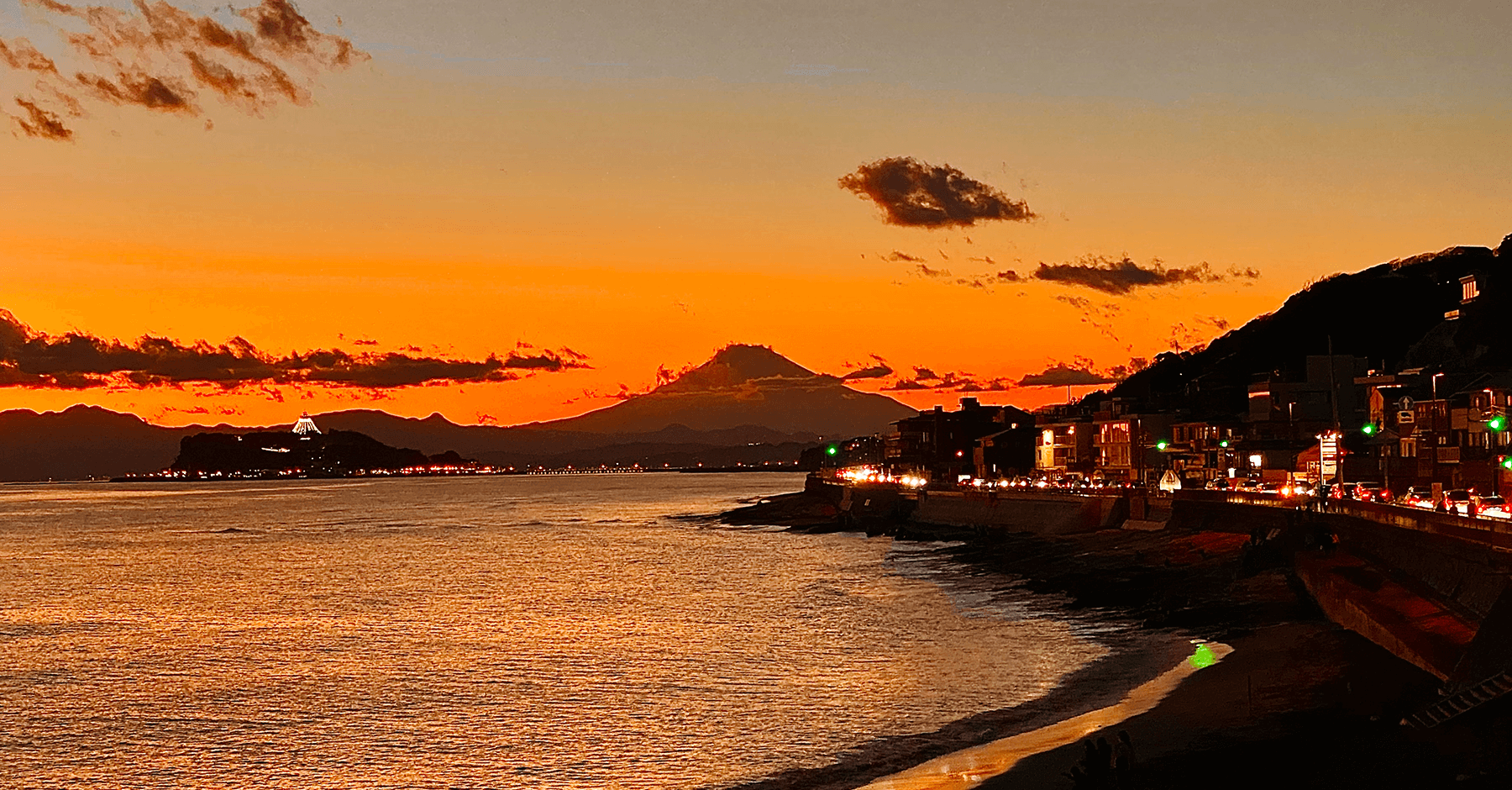
This spot is also known as location of the Legend of Tosho related to Nitta Yoshisada, the rival of Ashikaga Takauji, who attacked and destroyed the Kamakura Shogunate, and has been selected as one of the top 100 historic parks in Japan.
*Legend of Tosho: This legend states that when Nitta Yoshisada arrived to attack the Kamakura Shogunate, realizing that it was only possible to land at Inamuragasaki during low tide, he threw his sword into the sea and prayed to the dragon god of the sea, who pulled back the tide, allowing him to land and attack.
Basic information
Kamakura seaside park Inamuragasaki area
- Address
- Inamuragasaki, kamakura-si, kanagawa-ken
Google Map - Opening Hours
- Free
- Admission fee
- Free
- Parking
- No parking lot
- Web
- https://www.city.kamakura.kanagawa.jp/koen/p_kaihin.html
See the facility websites for the latest information.
MORE
SHUTOKO TIPS
The Metropolitan Expressway is a paid expressway exclusively for cars. Please be aware that you will be charged when traveling on it. The Metropolitan Expressway also provides ETC entrances and exits, so we recommend using an ETC card. See the page below for more information.
If you travel by car, you can visit places difficult to reach by train. Drive safely, enjoy the ride, and discover your new favorite destination in Japan.
See the facility websites for the latest information.

